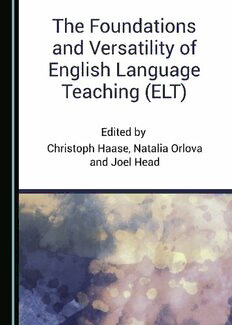
The Foundations and Versatility of English Language Teaching (ELT) PDF
Preview The Foundations and Versatility of English Language Teaching (ELT)
The Foundations and Versatility of English Language Teaching (ELT) The Foundations and Versatility of English Language Teaching (ELT) Edited by Christoph Haase, Natalia Orlova and Joel Head The Foundations and Versatility of English Language Teaching (ELT) Edited by Christoph Haase, Natalia Orlova and Joel Head This book first published 2018 Cambridge Scholars Publishing Lady Stephenson Library, Newcastle upon Tyne, NE6 2PA, UK British Library Cataloguing in Publication Data A catalogue record for this book is available from the British Library Copyright © 2018 by Christoph Haase, Natalia Orlova, Joel Head and contributors All rights for this book reserved. No part of this book may be reproduced, stored in a retrieval system, or transmitted, in any form or by any means, electronic, mechanical, photocopying, recording or otherwise, without the prior permission of the copyright owner. ISBN (10): 1-5275-0631-2 ISBN (13): 978-1-5275-0631-2 CONTENTS Preface ........................................................................................................ ix Acknowledgements .................................................................................... xi Section 1: Applied Linguistics and English Language Teaching Fostering Morphological Awareness in the Teacher Trainee Class: Some Reflections on –ous and Rival Adjectival Suffixes Silvia Cacchiani........................................................................................... 3 Exploring Formulaic Clusters in L2 English Expert Writing: Academic ELF Discourse Gabriela Zapletalová ................................................................................. 15 Computer-Assisted Language Learning: A Necessity for Language Learning and Teaching Dara Tafazoli and Maryam Rafiei ............................................................. 33 The Corpus of Czech Adult English: Design, Analysis and Future Expectations Kate(cid:284)ina Šteklová ...................................................................................... 47 Corpus & Discovery Learning in High-School Academic English and Academic Writing: COHAT and Other Corpora Róbert Bohát .............................................................................................. 57 The Leeds Corpus of Czech Learner English: Design Features and Data Collection Christoph Haase and Kate(cid:284)ina Šteklová ................................................... 75 The Awareness of the Complexity in English Function and Content Words by Polish Subjects in Different Proficiency Groups Adam Pluszczyk and Artur (cid:285)wi(cid:261)tek ........................................................... 91 vi Contents Language and Identity: English as a Part of Students’ Language Identity Construction Michaela Slezák Polónyová ..................................................................... 103 Folk Taxonomies Outside of the Domain of “Living Things”: Somewhat Odd Classifications Radek Vogel ............................................................................................. 115 Teaching Vowel Sounds: Differences between English and Czech Dušan Melen and Monika H(cid:284)eba(cid:254)ková ................................................... 133 Section 2: Approaches in English Language Teaching Methodology Student Teacher Views on What Makes a Good Host Teacher Natalia Orlova ......................................................................................... 147 Confidence in Language Learning Michael Hall ............................................................................................ 165 A Teacher Education Framework for Developing Teachers’ Competences for Plurilingual and Intercultural Education Paloma Castro and Elena González-Cascos ........................................... 175 Post-Project Development of Plurilingualism Understanding in Partner Context Lora Tamoši(cid:460)nien(cid:417) and Vilhelmina Vai(cid:254)i(cid:460)nien(cid:417) ..................................... 189 Section 3: ELT Perspectives on Cultural and Literary Studies Terrorist Recruitment and English: The Use of English as a Terrorist Language Mary Ellen Toffle ..................................................................................... 201 Two Poetic Vessels: The Human as Container and Contained Joel Cameron Head ................................................................................. 223 Teaching Postmodernist Fiction Zinaida Chemodurova ............................................................................. 233 Sky Woman and Windigo: Characters from Oral Storytelling in Contemporary Canadian Indigenous Literature Jana Marešová ........................................................................................ 251 The Foundations and Versatility of English Language Teaching (ELT) vii Black, White, and Yellow Blood: Race and the Rhetoric of Scientific Authority Mark Andrew Brandon ............................................................................ 261 Generational Conflicts in A Lesson before Dying by Ernest J. Gaines Aneta (cid:253)ervenková .................................................................................... 271 Ready-to-Serve FCE: A Review Stanislava Kaiserová ............................................................................... 277 Hilská – Harrisová – Woolfová: A Review Stanislava Kaiserová ............................................................................... 279 PREFACE While the field of ELT studies continues to see horizontal and vertical diversification, it is also time to take stock of what has made the discipline into the field it is today. In regard to horizontal diversification we can identify trends that involve a continued inclusion of more fields of study in the family of methods and approaches of ELT. Especially in the technical sense, e-learning has matured and new forms of online learning and teaching emerge, be it via teleconferences or short-message services for vocabulary training. But a massive extension has occurred in so-called social media. The vertical dimension affects a depth of analysis not seen even a decade ago when, for example, small and relatively simple learner corpora were used for linguistic analysis that rarely went beyond rote frequency counts. The increasing sophistication in these two dimensions – the horizontal and the vertical – is also reflected in the research papers collected in this volume. It is, like previous volumes, organized into three large thematic sections, beginning with applied linguistics, approaches in methodology and bookended by cultural and literary studies. In this volume, the linguistics section is spearheaded by the study by Silvia Cacchiani who reflects on the morphological competence of second- langauge learners of English, a theme that is carried a step further into lexical competence by Gabriela Zapletalová’s look at lexical clusters in L2 writing. Dara Tafazoli and Maryam Rafiei investigate recent approaches in CALL. The subsequent papers concern the compilation and use of corpora, first by Kate(cid:284)ina Šteklová who describes a novel corpus of adult Czech learners of English, then Róbert Bohát, Beata Rödlingová and Nina Horáková’s contribution on an academic corpus at the high school level adds the dimension of younger learners while Christoph Haase and Kate(cid:284)ina Šteklová’s corpus involves the youngest groups of preschoolers and first-year primary school pupils who are early acquirers of English as a second language. This age dimension is diversified further by Adam Pluszczyk and Artur (cid:285)wi(cid:261)tek who test different levels of proficiency on complexity issues in English. Identity construction is the topic of Michaela Slezák Polónyová’s study while Yuri Maslov details the conditions from the unusual perspective of Belarus. Two contributions of a more systematic linguistic nature are the theoretical one by Radek Vogel who analyses folk taxonomies of ‘living things’ while Dušan Melen and
